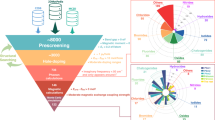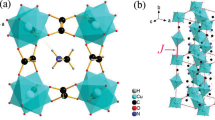Abstract
If magnetic semiconductors are ever to find wide application in real spintronic devices, their magnetic and electronic properties will require tailoring in much the same way that bandgaps are engineered in conventional semiconductors. Unfortunately, no systematic understanding yet exists of how, or even whether, properties such as Curie temperatures and bandgaps are related in magnetic semiconductors. Here we explore theoretically these and other relationships within 64 members of a single materials class, the Mn-doped II-IV-V2 chalcopyrites (where II, IV and V represent elements from groups II, IV and V, respectively); three of these compounds are already known experimentally to be ferromagnetic semiconductors. Our first-principles results reveal a variation of magnetic properties across different materials that cannot be explained by either of the two dominant models of ferromagnetism in semiconductors. On the basis of our results for structural, electronic and magnetic properties, we identify a small number of new stable chalcopyrites with excellent prospects for ferromagnetism.
This is a preview of subscription content, access via your institution
Access options
Subscribe to this journal
Receive 12 print issues and online access
$259.00 per year
only $21.58 per issue
Buy this article
- Purchase on Springer Link
- Instant access to full article PDF
Prices may be subject to local taxes which are calculated during checkout




Similar content being viewed by others
References
Ohno, H. Making nonmagnetic semiconductors ferromagnetic. Science 281, 951–956 (1998).
Maekawa, S. & Shinjo, T. (eds) Spin Dependent Transport in Magnetic Nanostructures (Taylor and Francis, New York, 2002).
Žutić, I., Fabian, J. & Das Sarma, S. Spintronics: Fundamentals and applications. Rev. Mod. Phys. 76, 323–410 (2004).
Dietl, T. Functional ferromagnetics. Nature Mater. 2, 646–648 (2003).
Dietl, T., Ohno, H., Matsukura, F., Cibert, J. & Ferrand, D. Zener model description of ferromagnetism in zinc-blende magnetic semiconductors. Science 287, 1019–1022 (2000).
König, J., Lin, H.-H. & MacDonald, A.H. Theory of diluted magnetic semiconductor ferromagnetism. Phys. Rev. Lett. 84, 5628–5631 (2000).
Chattopadhyay, A., Das Sarma, S. & Millis, A.J. Transition temperature of ferromagnetic semiconductors: A dynamical mean field study. Phys. Rev. Lett. 87, 227202 (2001).
Nagaev, E.L. Colossal Magnetoresistance and Phase Separation in Magnetic Semiconductors (Imperial College Press, London, 2002).
Medvedkin, G.A., Ishibashi, T., Hayata, T.N., Hasegawa, Y. & Sato, K. Room temperature ferromagnetism in novel diluted magnetic semiconductor Cd1-xMnxGeP2 . Jpn. J. Appl. Phys. 2 39, L949–L951 (2000).
Medvedkin, G.A. et al. New magnetic materials in ZnGeP2Mn chalcopyrite system. J. Cryst. Growth 236, 609–612 (2002).
Cho, S. et al. Room-temperature ferromagnetism in Zn1-xMnxGeP2 semiconductors. Phys. Rev. Lett. 88, 257203 (2002).
Choi, S. et al. Room-temperature ferromagnetism in chalcopyrite Mn-doped ZnSnAs2 single crystals. Solid State Commun. 122, 165–167 (2002).
Perdew, J.P. et al. Atoms, molecules, solids, and surfaces: Applications of the generalized gradient approximation for exchange and correlation. Phys. Rev. B 46, 6671–6687 (1992).
Kresse, G. & Hafner, J. Ab initio molecular dynamics for liquid metals. Phys. Rev. B 47, 558–561 (1993).
Kresse, G. & Furthmüller, J. Efficient iterative schemes for ab initio total-energy calculations using a plane-wave basis set. Phys. Rev. B 54, 11169–11186 (1996).
Mahadevan, P. & Zunger, A. Room-temperature ferromagnetism in Mn-doped semiconducting CdGeP2 . Phys. Rev. Lett. 88, 047205 (2002).
Continenza, A. et al. Structural and electronic properties of narrow-gap ABC2 chalcopyrite semiconductors. Phys. Rev. B 46, 10070–10077 (1992).
Zhang, S.B. The microscopic origin of the doping limits in semiconductors and wide-gap materials and recent developments in overcoming these limits: A review. J. Phys. Condens. Matter 14, R881–R903 (2002).
Erwin, S.C. & Hellberg, C.S. Predicted absence of ferromagnetism in manganese-doped diamond. Phys. Rev. B 68, 245206 (2003).
Kacman, P. Spin interactions in diluted magnetic semiconductors and magnetic semiconductor structures. Semicond. Sci. Technol. 16, R25–R39 (2001).
Van de Walle, C.G., Limpijumnong, S. & Neugebauer, J. First-principles studies of beryllium doping of GaN. Phys. Rev. B 63, 245205 (2001).
Zhao, Y.-J. & Zunger, A. Site preference for Mn substitution in spintronic CuMIIIX2VI chalcopyrite semiconductors. Phys. Rev. B 69, 075208 (2004).
Picozzi, S., Zhao, Y.-J., Freeman, A.J. & Delley, B. Mn-doped CuGaS2 chalcopyrites: An ab initio study of ferromagnetic semiconductors. Phys. Rev. B 66, 205206 (2002).
Dietl, T., Ohno, H. & Matsukura, F. Hole-mediated ferromagnetism in tetrahedrally coordinated semiconductors. Phys. Rev. B 63, 195205 (2001).
Pearton, S.J. et al. Wide band gap ferromagnetic semiconductors and oxides. J. Appl. Phys. 93, 1–13 (2003).
Acknowledgements
We thank G. A. Medvedkin for discussions. Computations were performed at the DoD Major Shared Resource Center at ASC. I.Ž. acknowledges financial support from the National Research Council. This work was supported by ONR and the DARPA SpinS program.
Author information
Authors and Affiliations
Corresponding author
Ethics declarations
Competing interests
The authors declare no competing financial interests.
Supplementary information
Supplementary Information, Fig. S1
Supplementary Information, Fig. S2 (PDF 71 kb)
Supplementary Information, Fig. S3
Rights and permissions
About this article
Cite this article
Erwin, S., Žutić, I. Tailoring ferromagnetic chalcopyrites. Nature Mater 3, 410–414 (2004). https://doi.org/10.1038/nmat1127
Received:
Accepted:
Published:
Issue Date:
DOI: https://doi.org/10.1038/nmat1127
This article is cited by
-
Spontaneous polarization study in A3+B4+(O2N)7− and A2+B5+(O2N)7− perovskite-type oxynitrides: a first principles investigation
Applied Physics A (2022)
-
Room-temperature synthesis of earth-abundant semiconductor ZnSiN2 on amorphous carbon
Scientific Reports (2021)
-
Li(Cd,Mn)P: a new cadmium based diluted ferromagnetic semiconductor with independent spin & charge doping
Scientific Reports (2019)
-
Modeling of Hypothetical BeXAs2 (X = Si, Ge, Sn) Crystal Structure and Phonon Spectra
Russian Physics Journal (2019)
-
Structural and Thermoelectronic Properties of Chalcopyrite MgSiX2 (X = P, As, Sb)
Journal of Electronic Materials (2017)



